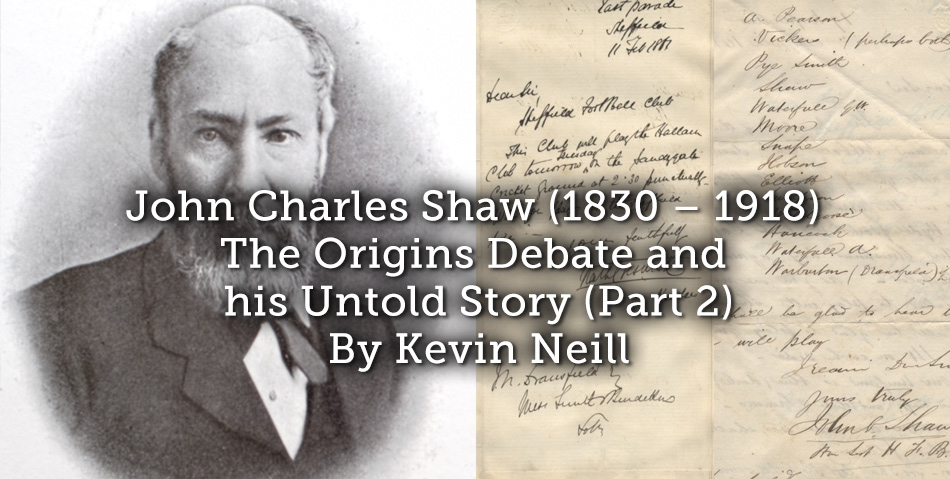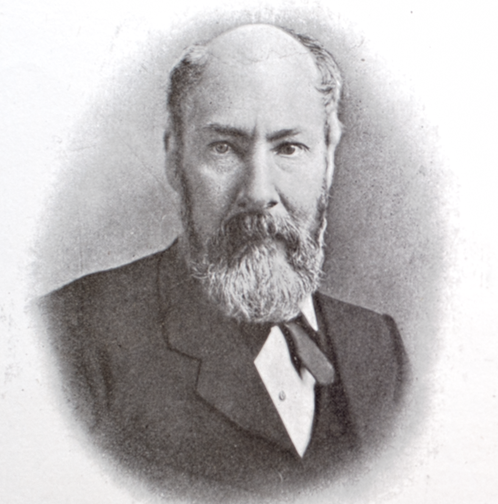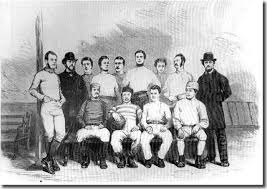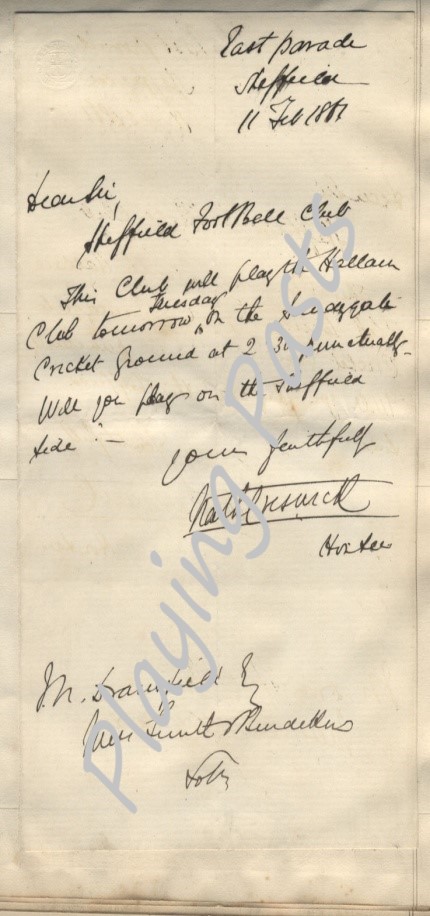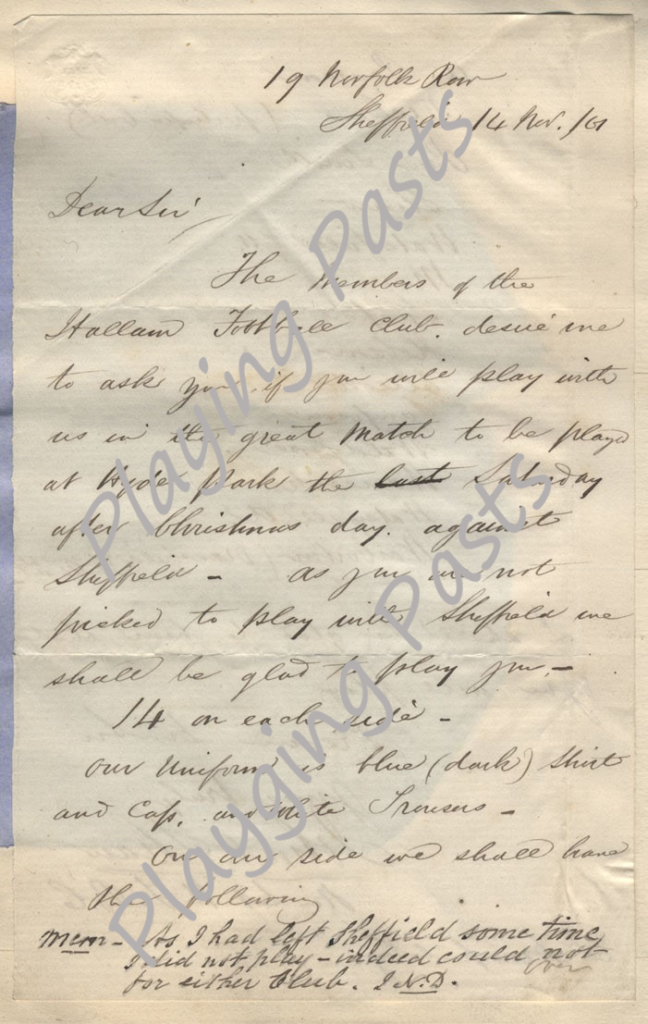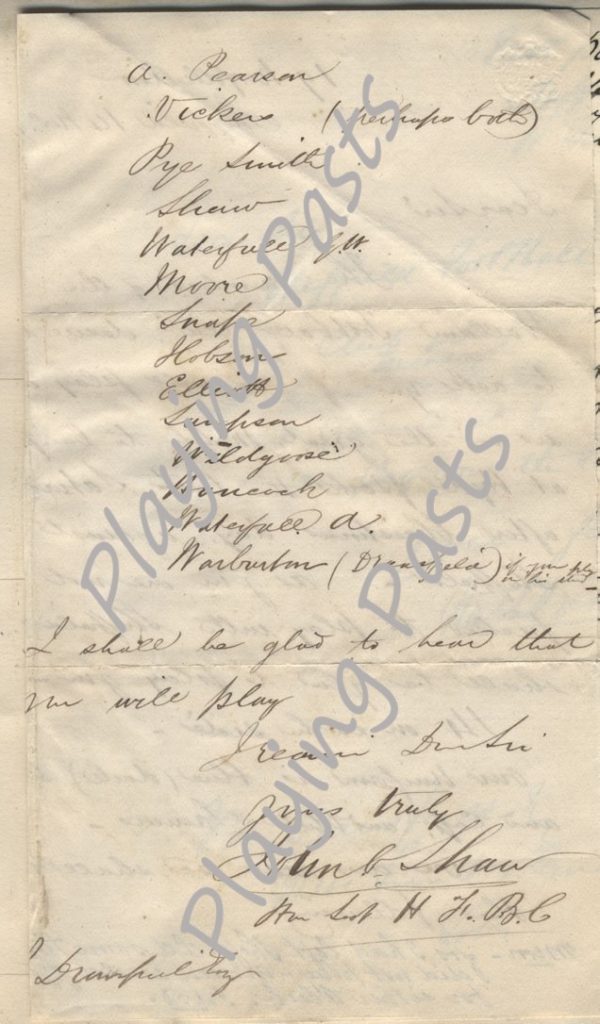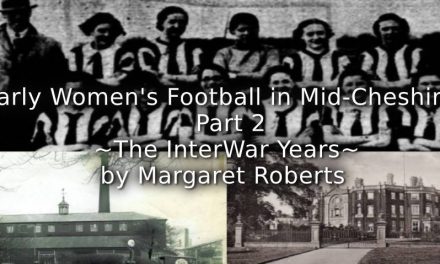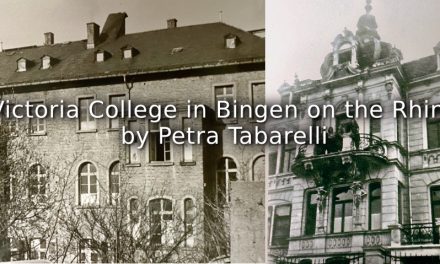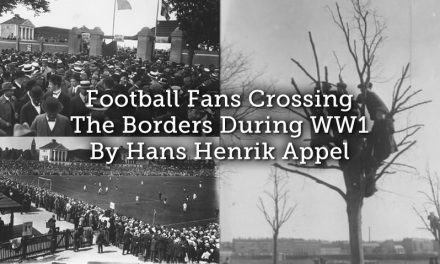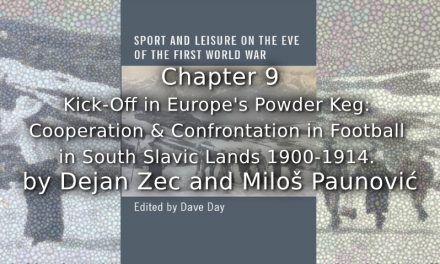To see Part 1 of the series – bit.ly/2EZYZDn
John Charles resided in Penistone until just shy of his fifteenth birthday, when he was articled to his uncle, John Shaw the surgeon of Attercliffe, Sheffield. It was no coincidence that the rail link between Penistone and Sheffield had been completed by this time. By his own admission, John Charles stated that he did not enjoy this profession and gave it up, spending four years in the office of Mr John Dixon, a solicitor in Sheffield. There is no evidence that he was articled here, nor is there any evidence that he passed law exams or even lived in Sheffield. John Charles Shaw never became a practising solicitor. Indeed, it would have barred him from his application to the Middle Temple in 1906. He also engaged a private tutor during this period, possibly the Mrs Jane Rennie, governess, who he was visiting in 1851. Martin Westby, in his book, A History of Sheffield Football 1857-1889, talks of a letter that was within the archive material of the Sheffield Football Club sold at Sotheby’s in 2011. The auction catalogue transcripts say the letter was written by a John N Deansfield to Harry Walker Chambers regarding the early days of Sheffield Foot Ball Club. The person named Deansfield was, actually, John Ness Dransfield. Both he and Chambers were well qualified for such a discussion, both being members of the club in the early days and both known to each other as pupils of George Rider’s school in Grenoside, a village close to Sheffield. Dransfield points out to Chambers that he recalls John Charles Shaw playing football in the fields opposite his father’s offices in Penistone. In the 1851 census, John Charles Shaw is recorded as an Attorney’s Clerk. Dransfield Senior is shown as a Solicitor and Attorney at Law, employing two Clerks. In 1853, John Charles is a Clerk, more than likely in the Dransfield solicitors’ office, where he would have been well known and living in Penistone, or as it states on his marriage certificate, Barnsley. Little wonder, that twelve year old Dransfield, who loved his football, remembered this occasion, when reminiscing as an eighty eight year old in 1928.
-
John Ness Dransfield
Taken from the frontispiece of his book A History of Penistone 1906.
It is Dransfield that has provided much of the material used to research the impact of Penistone on the early development of football in Sheffield.
He was a member of the Sheffield Foot Ball Club 1860-61 when completing his articles with Smith & Bundekin
There have been many questions asked, in various writings, as to why Sheffield Foot Ball Club was formed in 1857. The major issue regarding the playing of football in Sheffield asked by Richard Sanders in his book Beastly Fury was, ‘So where had they learned the game?’It is very possible that when articled to his uncle John, the surgeon, John Charles came across a young man by the name of Henry Joseph Garnett who was training to be a surgeon dentist, like his father Henry William Garnett. Probably during this time, he met a young girl, the sister of Henry Joseph, who was to become his wife, Mary Ann Garnett. They were married in 1853 John aged 23 and his wife 19. Possibly, Mary’s father set John Charles up in business. It is no coincidence that Henry Joseph was in practice at number 12 Norfolk Row and John Charles was now at number 19. Norfolk Row is only a short distance from East Bank Park in Sheffield, which is the parkland area where it is reputed that football was initially played in the town. As a young man, John Charles would have still have wanted to engage himself in the exercise of his choice, namely football and athletics. Others, such as Nathaniel Creswick and William Prest preferred cricket and athletics. Whilst these were summer sports, the gymnasium was their preferred winter occupation.
If this question is taken into account, then the importation of the Penistone game via John Charles Shaw is not too implausible. Consideration must be given to the knock on and fair catch, which were features of the environment around Penistone. In 1871 at the Annual General Meeting (AGM) of the Sheffield Football Association, an address was given by Mr Houseman of the South Derbyshire Football Association, who was looking at his association joining ranks with that of Sheffield. Houseman stated that the eleven clubs of his association as well as the Nottingham Forest Club would join the Sheffield association, if they abolished catching. The report, in the Sheffield Daily Telegraph (10 October 1871) noted the following:
‘[an] animated discussion ensued, the supporters of catching urging that the grounds in Sheffield and neighbourhood were unfit for the non-catching rule, on account of their hilly nature’.
This implies that football in Sheffield had been played throughout the town and surrounding area before 1857. This is not necessarily the case. It is more likely that the rules of knocking on and a fair catch were other importations via John Charles Shaw from Penistone in the early 1850s. Consider the former question of why 1857. Debate has continued on and off as to whether the Sheffield club was formed earlier than this. That football was played in Sheffield earlier is undoubted, but on an ad hoc, voluntary nature that suited the participants. Tony Mason, in Association Football & English Society makes a vital contribution, stating, ‘the formation of clubs is not necessary in order to play football’.
He also makes the point that, in order for a club to begin, there has to be a base from which it can start. Informal kick-abouts had been part of the East Bank scene for some time, as young men from surrounding businesses and industry got together to enjoy a game. This could also lend itself to the notion that there was a semblance of an organised group in 1855, as discussed by Graham Curry in Early Sheffield Football. A Source Book. Westby refers to another letter in the Sotheby’s sale. This letter was written by John Charles Shaw to J. C. Bingham (President of the Sheffield Club) in 1907, and part of it says, ‘for many years we had to arrange alphabetical sides to make the games interesting’
There is an argument that this statement relates to the actual date of the founding of the Hallam Club, in order to facilitate competition with the Sheffield Club. ‘For many years’, however, could imply the ad hoc, informal, pre-club games from the early 1850s and suggests a semi-organised group before 1857.
A number of events happened leading up to 1857 that could have influenced the decision to create the football club at this particular time and not before. Armed conflicts involving the country were taking place abroad and the threat of a possible invasion triggered the volunteer movement in Sheffield. Nathaniel Creswick and William Prest were very keen on the military aspect, preparation for war and the leadership of men were their priorities. A possible source of recruits could be drawn from a cricket/football club giving year round access to potential volunteers. Creswick and Prest were cricket and athletics people. Conditioning for war and leadership was done through the gymnasium and both were members of two of the leading gymnasiums in the area. At this time they probably considered football uncouth and unfit for military leaders to participate in. An interesting report given in the Sheffield Daily Telegraph on May 19th 1904, which was written to celebrate the Amateur Cup triumph, possibly lends support to this. It reads:
‘About 1852, however, a Mr Percy had rented a room in Orchard Lane as a teacher of fencing and, attracting many Sheffield gentlemen to his room, a gymnasium was eventually formed at the foot of College Street under Percy’s management, and one of which was without doubt the finest in England. Messrs Burberry, Prest and Creswick were amongst the members, and when, after four or five years the gymnasium had to be given up, there came the Sheffield Football Club in 1856 or 1857, absolutely the first such club in the country.’
Westby alludes to winter conditioning in the gymnasium as a preferred option for Creswick and Prest in his book, whilst six months prior to the founding of the club, the novel, Tom Brown’s Schooldays. By an Old Boy had been published. This was a best seller and was undoubtedly read by the elite of Sheffield. It promoted the development of moral standards and courage through the playing of games by the nation’s elite. Football was prominent in this notion of muscular Christianity and, as a result, football developed credence, almost approval, and, more to the point provided a winter outlet for conditioning that had been previously provided by the gymnasium. Both Creswick and Prest, through their experience of organised cricket, knew that a football club would probably guarantee regular games in a structured manner. The Sheffield Foot Ball club was formed in October 1857, the same month that recruitment for the volunteers took place. If Creswick also wished to give the game further credibility in the eyes of the social elite, then the introduction of the rouge in the 1860s, possibly borrowed from the Eton Field game, may well have been an attempt to do just that. Dransfield gives an indication that Tom Brown’s Schooldays had an impact on the Sheffield club members. The ‘Barby Hill’ hare and hounds run which was described in the book, was a distance of six and a half miles. The prestigious ‘Crick Run’ however, for the older pupils covered thirteen miles. Dransfield records that on April 6th 1861, he and several members of the club took part in a paper chase (fox and hounds) which started at Eastbank [sic] and went via Ranmoor, Worall, Oughtibridge through Wharncliffe to Wortley. He goes on to write ‘Creswick and Baker were the foxes, David Sellars, Sanderson, Sorby, Chambers and myself the hounds. Chambers gave up soon after starting, Sanderson was done up at Oughtibridge and put to bed there. David Sellars passed Baker at Wharncliffe Lodge and got in sight of Creswick. Foxes started at 2.45, hounds 3.15. Foxes got to Wortley about 6.15, Sellars soon after. Sorby and I about 6.45. Distance about 15 miles. We had dinner at Wortley and a party from Sheffield met us. There was a coach in which we drove home’. An interesting point meriting consideration of the early stages of the club and that Creswick and Prest were novices to the game is raised by John Ness Dransfield and on two separate occasions. The first time is in his book History of Penistone written in 1906. Here he contributes a section on the Sheffield Football Club. Dransfield had been a member of the club in the 1860-61 season. He states,
‘If not the first, Mr John C. Shaw, a native of Penistone and who when a boy was a clerk in my father’s office, and for many years past has been one of the oldest and best-known Conservative agents in the Kingdom, was one of the first captains of the Sheffield Football Club; and just previous to my joining Mr John Marsh, a native of Thurlstone, had been captain. Mr Nathaniel Creswick was captain when I was at the club’.
The second time Dransfield alludes to this is in another piece of writing (unpublished) in 1912 entitled ‘Sheffield Football Club Penistone Players’. In this work he again states,
‘John C. Shaw (whom I am pleased to say is still living and a J.P. at Birmingham) a native of Penistone and when a youth was a clerk in my father’s office he afterwards became a law stationer in Sheffield and was I believe the first captain of the Sheffield Club. He was a very active player and a noted runner. Then Mr C.B. Stuart Wortley the first conservative member for the old undivided Borough of Sheffield was elected Mr J. Shaw acted as his agent and has now for many years past become one of the oldest and most successful, best known conservative agents in the kingdom. John Marsh a native of Thurlstone near Penistone who carried on business in Sheffield succeeded Mr Shaw-on the latter becoming captain of the Hallam Club in whose district he resided, as captain of the Sheffield club’.
-
John Marsh, almost certainly holding the ball, was Captain of the Sheffield Association representative team on many occasions.
Engraving of the team Sheffield v London, Oval, 3rd January 1874
The use of the word ‘afterwards’ indicates almost certainly that John Charles was employed by Dransfield Senior prior to him marrying and then moving to Sheffield, where he had been set up in business. There is no evidence to disbelieve these statements. The club captain would have been drawn from the best of the players. If Creswick had taken no part in the football prior to the club being formed, then his skills would need developing before taking on this role. It is interesting that John Marsh was also involved in this. An excellent player, Marsh was employed as an engraver in the factory where Creswick was a director. Both were known to each other. Possibly, Shaw may have been involved in introducing Marsh to Creswick. Shaw certainly knew Marsh and his family, as seen from the 1861 census, where he is employing Thurza Moorhouse, who was John Marsh’s aunt. Dransfield mentions, in the same document, that he first came across the large footballs, now in use, at the Liverpool Institute in the early 1850s. This means that he was used to playing football with a smaller ball, whilst at Penistone. Curry alludes to the notion that this lent itself towards a dribbling style of game on which Shaw, Marsh and Dransfield were brought up. Another issue worth consideration is the notion that, because seventeen members of the Sheffield Club were old boys of Collegiate College, the school must have been the hub of football in Sheffield. This figure could have included John Charles Shaw who prior to this article had been considered as a Collegiate old boy. The figure is therefore sixteen. There were fifty seven members in 1859. Sixteen is approximately twenty eight percent of the membership cohort. The obvious question which historians seem to have avoided is the unrecorded educational backgrounds of the remaining forty three players representing seventy two percent. Additional research into this would be most revealing. Adrian Harvey in Football: The First Hundred Years The Untold Story is more succinct in his findings saying, ‘there is no reason for linking the code of the Sheffield FC with any game they might have experienced while pupils at the Collegiate’
The following letters were discovered by the author during the course of research
Letters received by Dransfield from Nathaniel Creswick of the Sheffield Foot Ball Club and John Charles Shaw of the Hallam Foot Ball Club respectively. They are dated Feb/Nov 1861.
It is believed that they are the oldest football club letters in the world and have never been published prior to this article.
Article © Kevin Neill
To read Part 3 see – bit.ly/2ZdrvZV and Part 4 – bit.ly/2WXDYUe

